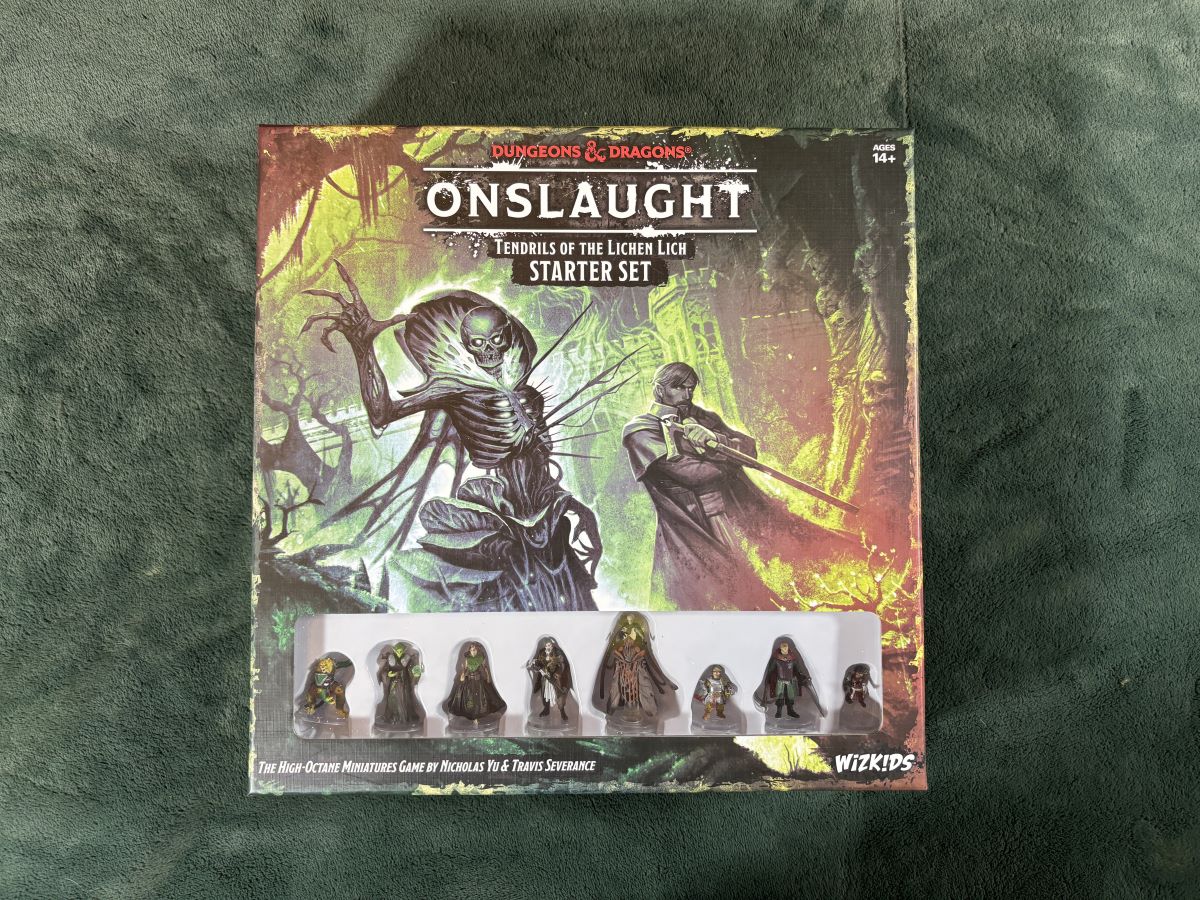Dungeons & Dragons is celebrating its 50th anniversary this year. Over a year ago, Dungeons & Dragons: Onslaught was released in which players engaged in combat skirmishes between adventure parties set in the D&D world. It is a great game and earned our GeekDad Approved! award. Several expansions have been released. Now a new set has been released to allow those who have not played the game to quickly get into the game with Dungeons & Dragons: Onslaught–Tendrils of the Lichen Lich starter set.
What Is Dungeons & Dragons: Onslaught–Tendrils of the Lichen Lich?
Dungeons & Dragons: Onslaught–Tendrils of the Lichen Lich is a competitive skirmish game for 2 players, ages 14 and up, and takes about 90 minutes to play. Each player takes control of a party of adventurers and fights against not only the opposing party but monsters who attack everyone. It’s currently available from your FLGS or online retailers such as Amazon with a suggested retail price of $99.99 for a copy of the game. Currently Amazon has a sale where you can save $10 or more on the game.
Dungeons & Dragons: Onslaught–Tendrils of the Lichen Lich was designed by Nicholas Yu and Travis Severance and published by WizKids, with graphic design by Richard Dadisman and art by Gong Studios.
Dungeons & Dragons: Onslaught–Tendrils of the Lichen Lich Components
Here is what you get in the game box:
- 8 Fully-Painted Miniatures
- 4 Double-Sided Map Tiles
- 4 Twenty-Sided Dice
- 9 Combat Dial Cards
- 2 Champion Cards
- 26 Standard Cards
- 27 Mini Cards
- 95 Tokens
- 1 Token Bag
- 19 Terrain Elements
- 1 Rule Book
- 1 Scenario Guide
- 1 Terrain Reference Sheet
- 4 Plastic Standees
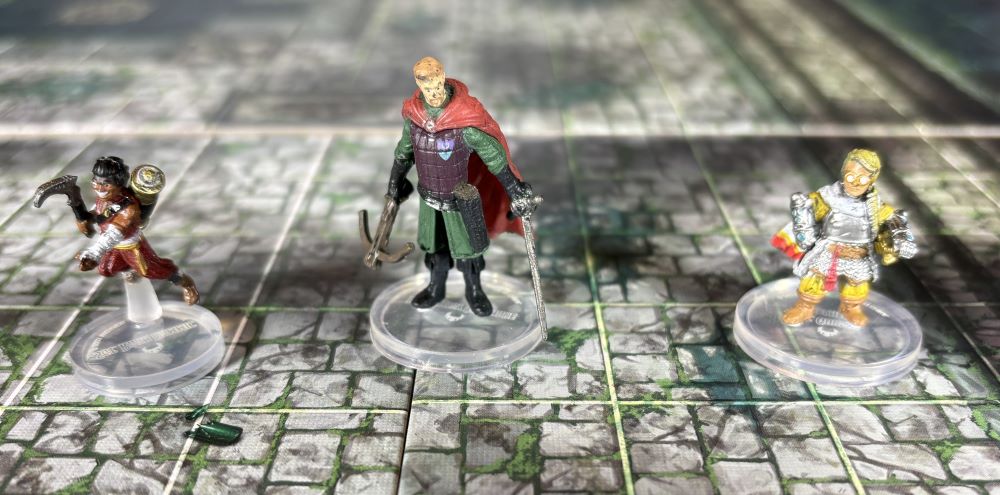
One of the two factions included in the game, The Lord’s Alliance is a partnership of merchant cities to form an army and defensive force to protect against thieves. This faction includes three characters: Lt. Gurena Steelheart, Lt. Ramsay Oakshade, and Sgt. Raan Dammic.
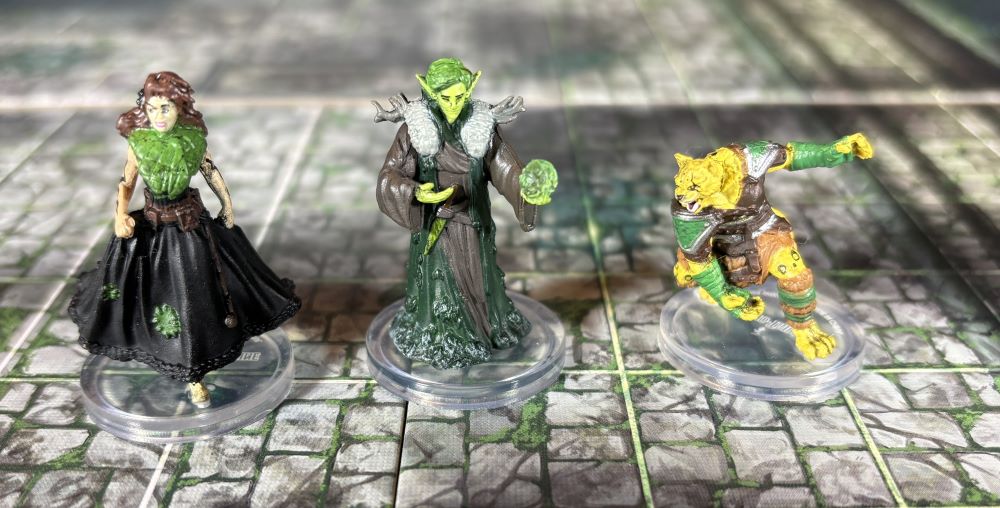
The second faction in the game, the Emerald Enclave often live deep in the wilderness and are charged with defending sacred gives and preserving the natural balance. This faction includes three characters as well: Two-Tails, Huiyol Meliamne, and Barefoot Madeleine.
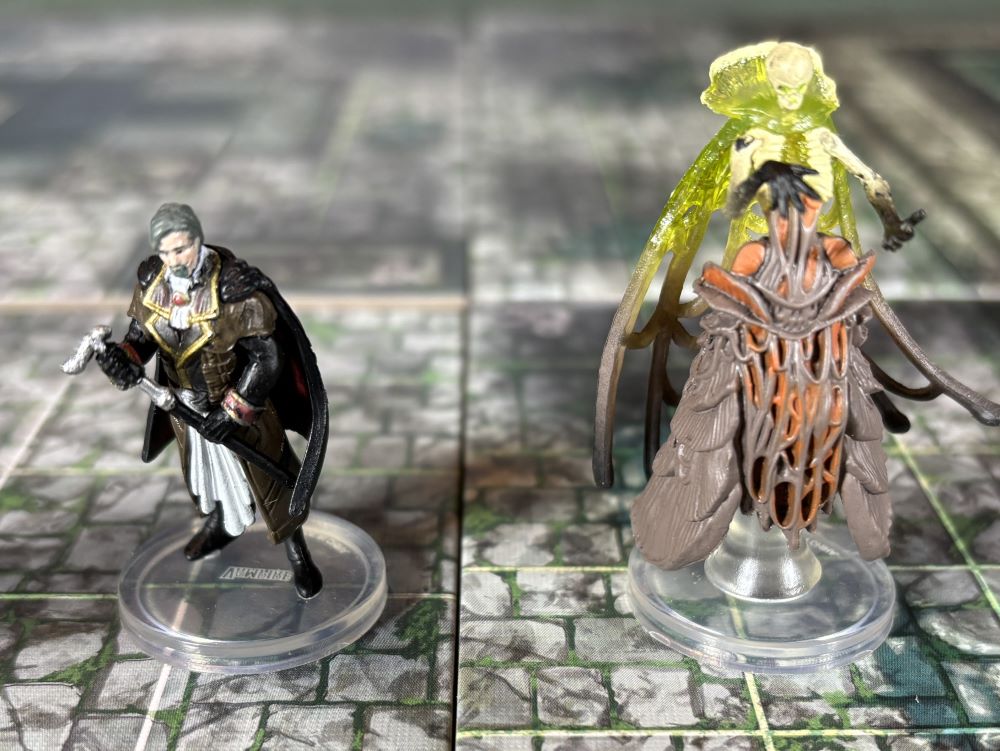
In addition to fighting against each other, the factions must also battle against monsters. This starter set includes miniatures for the Lichen Lich and Lord Victor Ambersmark. There are also wererats and skeletons that are represented by tokens.
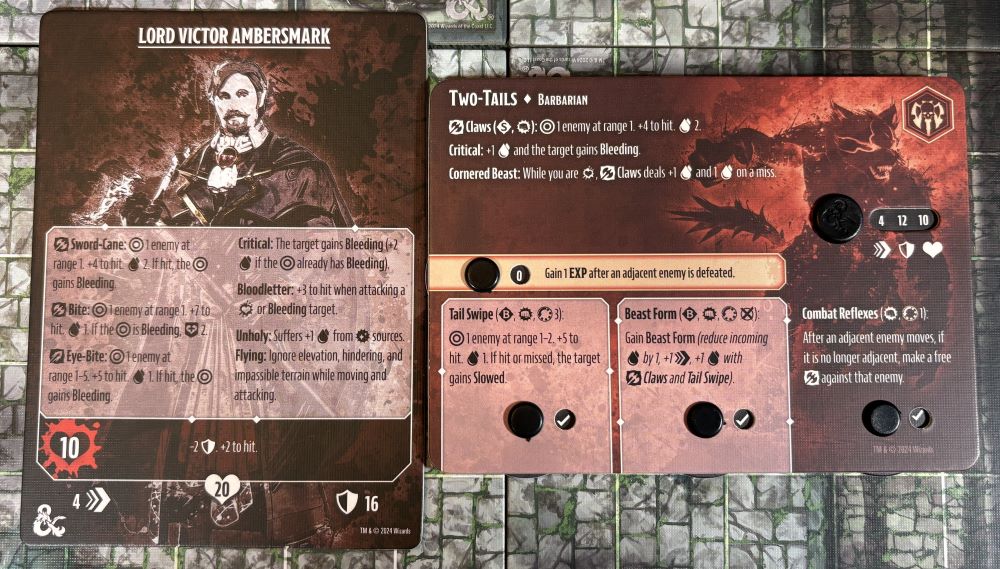
Dial cards contain all of the information needed for each character. They also use dials to keep track of important stats such as health, speed, and armor as well as cool-downs for special abilities and effects. There are also two champion tracker dial cards for keeping track of health for champion monsters.
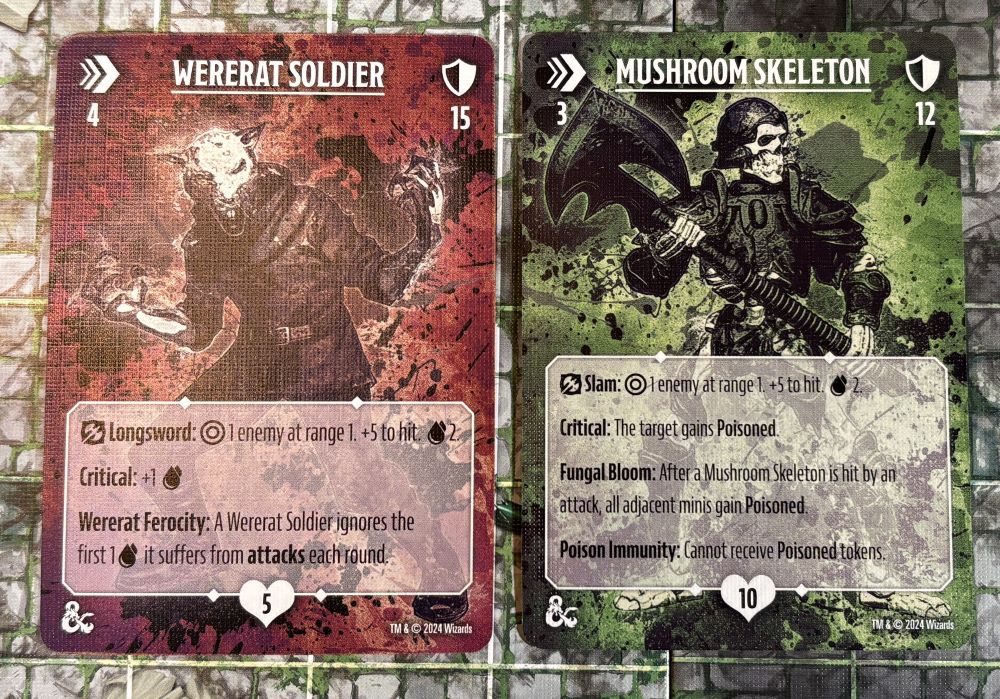
The monster cards provide information about the monsters similar to what is located on the dial cards.
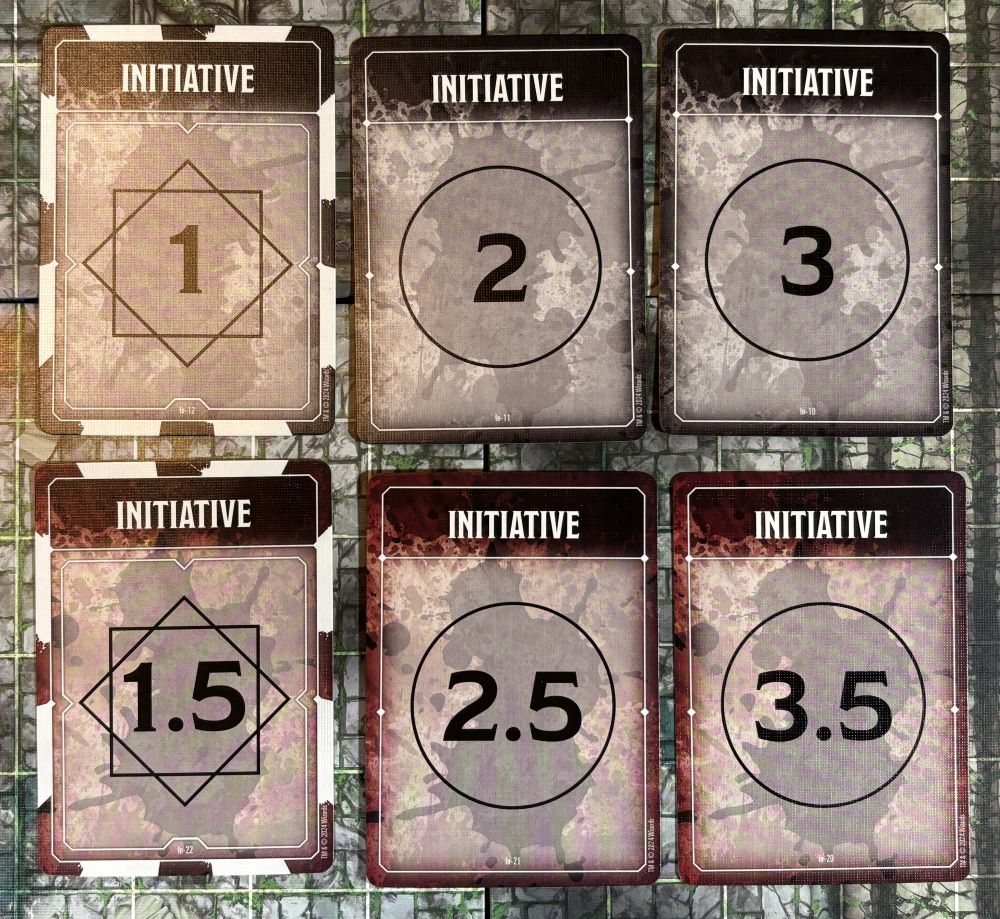
The initiative cards are used determine the order in which characters and monsters take their turns. Player initiative cards are always whole numbers while monster initiatives cards have numbers between the player cards such as 1.5, 2.5, and so forth.
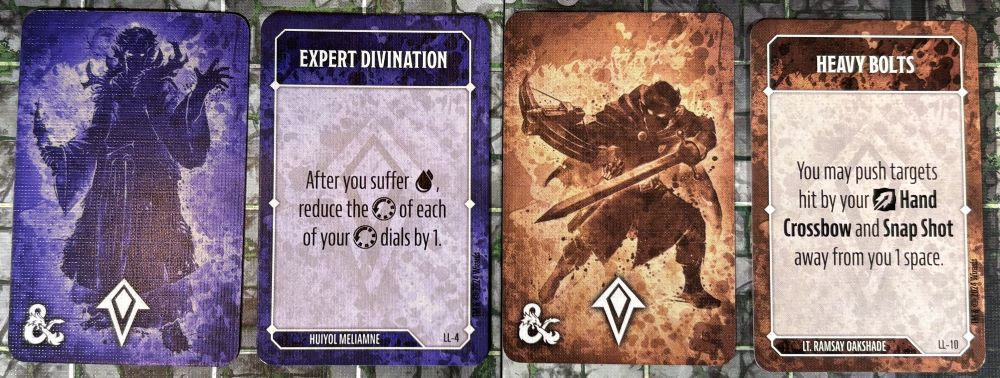
Each of the 6 characters have two specific level up cards. During a game, when a character gains enough experience points so that dial shows the level up symbol, the player can choose one of the two level up cards for that character. Some of these cards are active throughout the rest of the game while some can only be used once and are then exhausted.
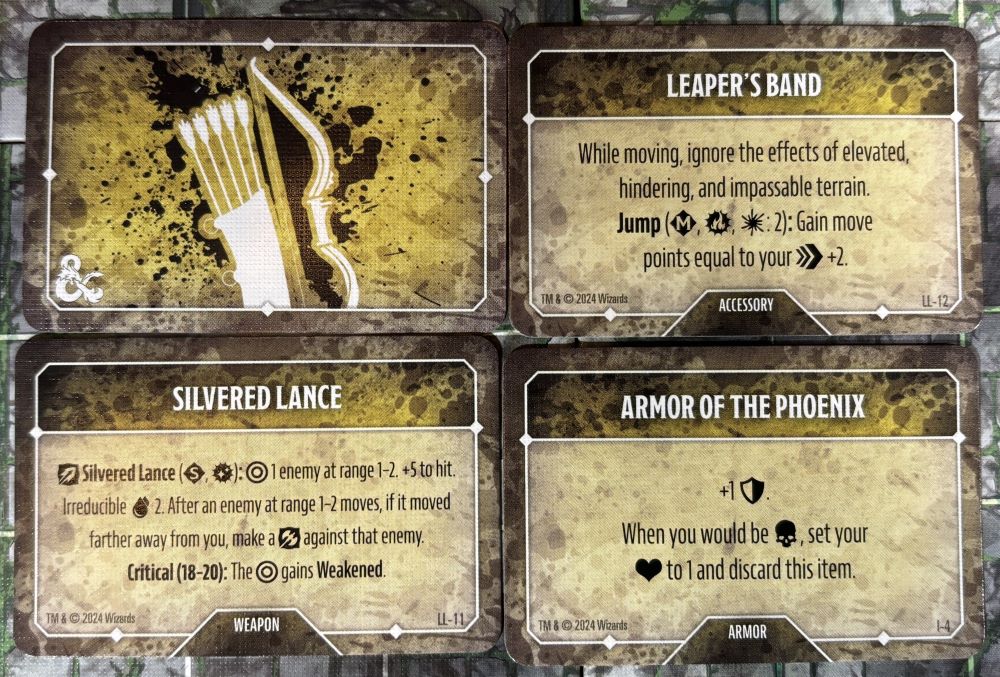
The 15 item cards are used to represent items the players discover during a game. They can be weapons or equipment used by the characters or things that are integral to the current scenario such as keys. Some have passive abilities while others are used once and then exhausted.
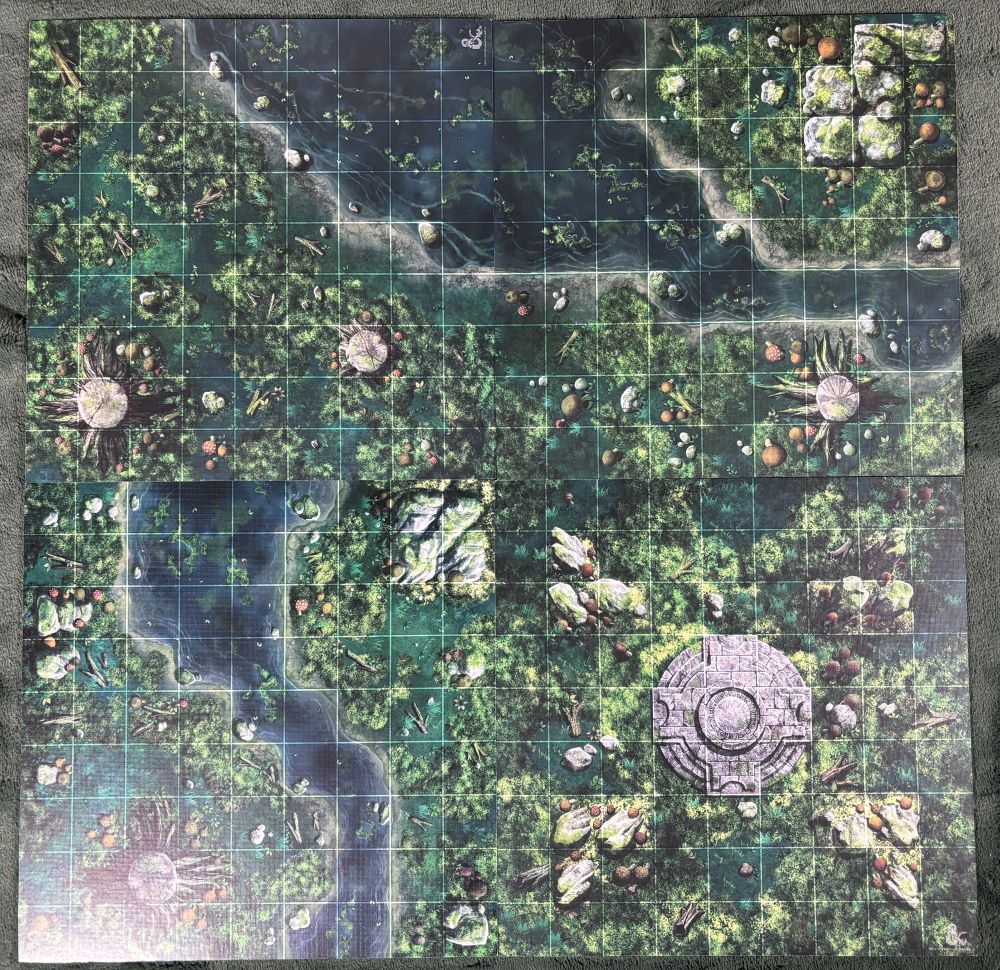
The game comes with four double sided map tiles which can be placed together to create a map.
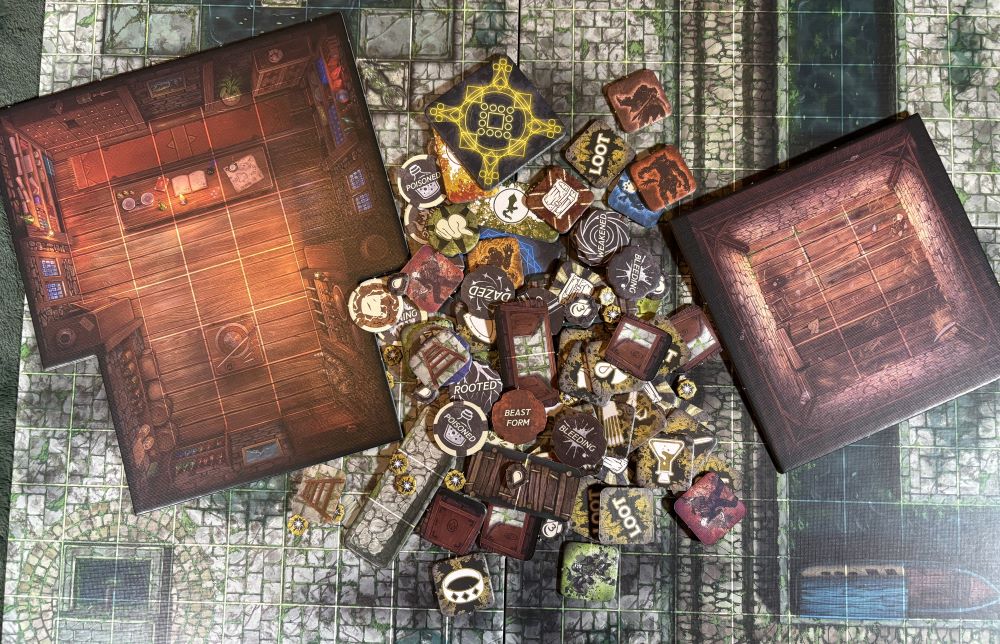
Dungeons & Dragons: Onslaught–Tendrils of the Lichen Lich includes many different tokens that are used for loot, treasure, conditions, and much more. There are also 19 terrain elements which can be placed on the map as called out in scenarios to represent doors, walls, ladders, bridges, a general store, a storage shed, control points, and end zones.
How to Play Dungeons & Dragons: Onslaught–Tendrils of the Lichen Lich
The Goal
The goal of the game is to defeat all of your opponents characters and earn victory points.
Setup
At the start, players choose which faction they will play as. They then take the three characters from their faction, each with a different role. Players place the character cards, level up cards, and character tokens in front of them. The map for the chosen scenario is created using the map tiles and placed in the middle of the play area. Each player sets their characters’ battle wheels on their character cards to their maximum hit points and each of the cooldown dials to the ready symbol. Players then place their character miniatures onto the map according to the scenario instructions. The tracker card is placed near the map and the round counter on it set to 1.
Next the monsters are prepared. Following the directions in the scenario, the monster miniatures, tokens, and monster cards are collected. Dials are set accordingly and the monster miniatures or tokens are placed on the map as indicated in the scenario. The monster initiative cards are placed next to the monster cards. Chest tokens and other tokens and/or terrain features are placed on the map. The loot is prepared as directed. Item cards for that scenario are set aside and the designated loot tokens are placed in the token bag. Unless stated otherwise in the scenario, players each roll two dice and compare their highest results. The winner chooses which player gets the initiative 1 card and becomes the active player at the start. You are now ready to begin the game.
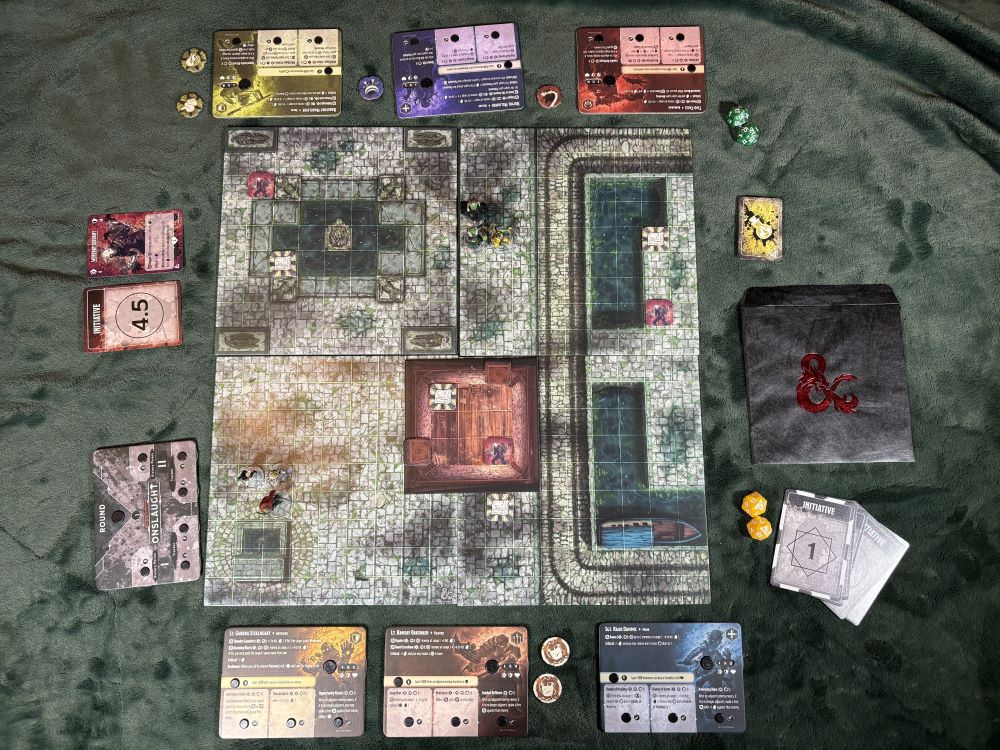
Gameplay
Dungeons & Dragons: Onslaught–Tendrils of the Lichen Lich is played over a series of rounds, usually consisting of 6 rounds unless otherwise stated in the scenario. Each round is divided into three phases: initiative, action, and end phases. Let’s take a look at each phase in turn.
Initiative Phase
During this phase, players determine the order in which characters activate over the course of the current game round. The active player, which was chosen during setup, shuffles initiative cards 2-6 and then randomly deals three cards to their opponent and two cards to themselves. Now the active player chooses one of their character cards and places the initiative 1 cards on it face up. The players then secretly assign the remaining initiative cards by placing one facedown on each of the other character cards.
Action Phase
Characters and monsters activate during this phase in the order of their initiative cards beginning with 1. When a character activates, the player who controls it can perform actions with it and upon completion of the actions, remove all fading conditions which were not assigned during the current activation. A character can perform one standard action, 1 move action, 1 bonus action, and any number of free actions for its activation. Attacks are usually standard actions. A character can forgo a standard action to take an additional move action and standard and move actions can be changed to additional bonus actions.
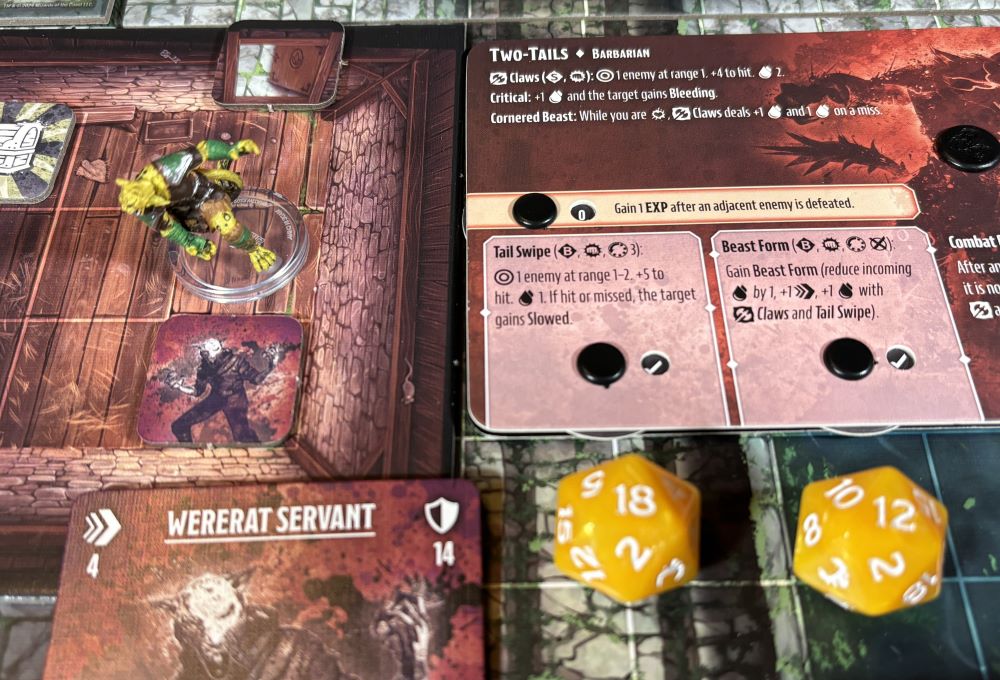
For a move action, the player looks at the character’s speed on its battle wheel and gain a number of move points equal to its speed. Characters must move orthogonally and not diagonally. It usually costs one move point to move one space. Moving into a space with hindering terrain or one elevation higher costs two move points. Characters cannot move onto or through blocking terrain.
Each character can one or more basic attacks listed at the top of their character card. They may also have one or two abilities with cooldown dials at the bottom of their card which act as attacks. Attacks often count as standard actions, but a few may cost both a standard and move action. To make an attack, the controlling player chooses one of the characters attacks. If the attack has a cooldown dial, rotate the dial one space counter-clockwise. Now choose one or more targets that are in range and line of sight (not behind blocking terrain, enemy miniatures, or elevated terrain). A melee attack must be against an target adjacent to the character. The target can be diagonally or orthogonally adjacent. Ranged attacks are usually against targets 2 or more spaces away. Next it is determined if the target is in cover. This means that the target is partially blocked by blocking, hindering, or elevated terrain or enemy miniatures. Now the player rolls two dice (only one die if the target has cover). The player chooses the highest number rolled, adds any modifiers such as attack modifiers, and then compares the result against the target’s armor class. If the final number is greater or equal to the armor value, then the target is hit. The target suffers damage equal to the damage value of the attack and their battle wheel is reduced accordingly. Defeated monsters are removed from the map while defeated characters have their miniature removed and replaced with their defeated character token. If during an attack, an unmodified or natural 20 is rolled, it automatically succeeds and a critical bonus is applied as listed on the character card. If a natural 1 is rolled and the other dice is not a natural 20, then the roll automatically fails, even if the other die would have been a noncritical success.
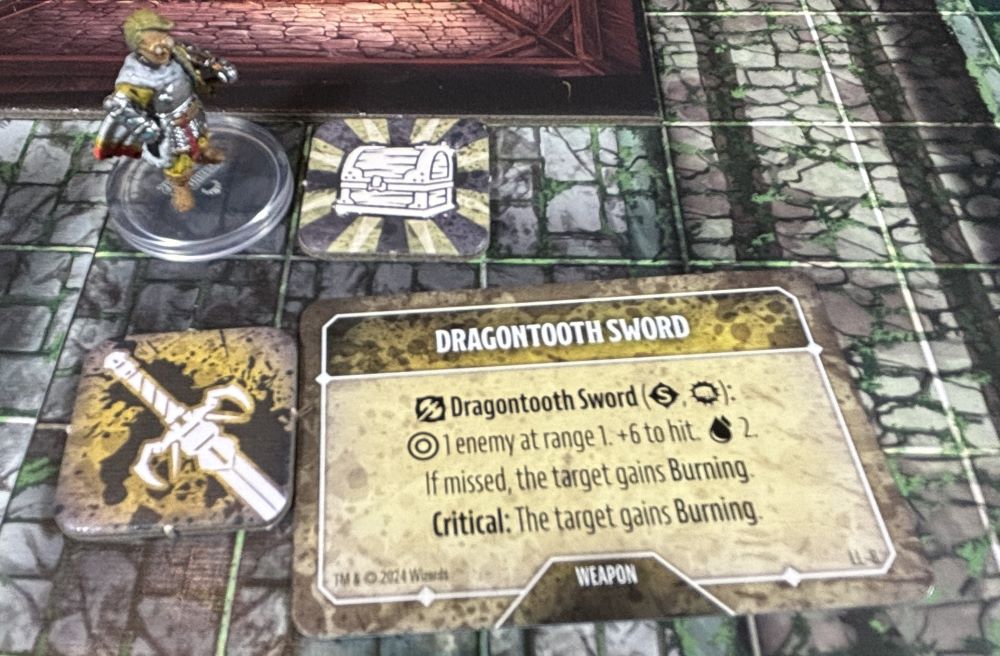
Some characters have other actions they can take as well. These may include healing themselves or other characters. These have cooldown dials and may have range requirements. When healing, rotate the battle wheel of the target to increase its hit points. Healing cannot raise the hit points above the character’s maximum nor can it be used on a defeated character. Each character also has a reaction ability which are performed in response to a specific trigger. Often it is when an adjacent enemy moves away from the character. These can only be performed if the reaction cooldown dial is set to ready.
Monsters activate according to their monster initiative card. If there are more than one monster of that type that activates, the one closest to the northwest corner of the map goes first. The scenario usually describes what a monster does during its activation. Normally it will move towards the closest character. In case of a tie, the non-active player chooses. It will then attack the closest target. In case of a tie, the active player’s character is chosen as the target or the non-active player chooses if there is still more than one possible target. The attack process follows the same steps as a character attack, but the player whose character is not being attacked rolls for the monster. After one monster of a group is finished with its activation, then activate the next until all have activated.
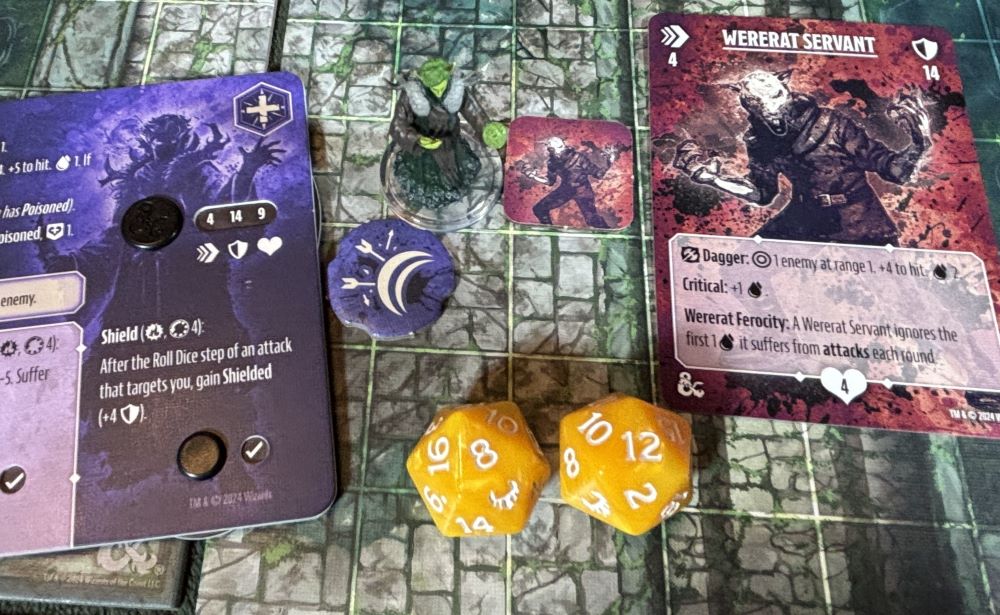
End Phase
Once all characters and monsters have activated in their turn, the end phase begins and players prepare for the next round. First any effects that trigger at the end of the round are resolved, starting with the active player. Next reduce each cooldown dial by one unless they show either a ready or exhausted symbol. Advance the round counter on the tracker card. Finally, the active player passes the initiative 1 card to the other player who will be the active player for the next round.
Game End
The game ends when all of one player’s characters are defeated which results in a victory for the other player. Otherwise it ends at the end of 6 rounds (or number of rounds specified by the scenario). Players add up their victory points which are earned according to the scenario and the player with the most victory points is the winner.
Why You Should Play Dungeons & Dragons: Onslaught–Tendrils of the Lichen Lich
Dungeons & Dragons: Onslaught–Tendrils of the Lichen Lich is a great game in its own right, without even considering the fact that it it themed around an popular intellectual property. First off, it comes with quality components. The cards and tokens are of good stock and the 8 pre-painted miniatures look great. I like how on the bottom of their base they also include the name of the character and faction or the name of the monster to help ensure players are using the correct miniature. The dial cards are a wonderful way to keep track of changing stats. Each character has their own dial card. The champion monsters have separate, small dial cards that are used along with their monster cards to keep track of their health. What I really like about the character dial cards is that they have all the information about the character that you need without having to use counters or tokens. Not only does one dial keep track of the characters speed, armor, and health, the other dials keep track of experience and cool-downs for abilities. This helps maintain the feel of the Dungeons & Dragons role-playing game with lots of options for characters while keeping things simple for a skirmish so players can focus on the fight rather than record keeping. At first, all the icons and symbols listed next to each ability or attack can seem confusing, so the inclusion of reference cards really helps new players.
Another feature of the Dungeons & Dragons: Onslaught system that I really like is how quick you can get into a game. There are six scenarios that form a campaign and provide all the details you need to setup these games. There is also a 4-player team scenario which requires more characters from other Onslaught products. The nice feature of the first scenario is that it not only provides some additional details to help new players setup the game, it also includes a sample round that demonstrates the initiative system, movement, attacks, determining line of sight and cover, how monsters activate and act, and even how to use characters’ special abilities. This is also great for players who have not played Onslaught recently to get back into the system. This walkthrough does a great job of tying all of the rules together.
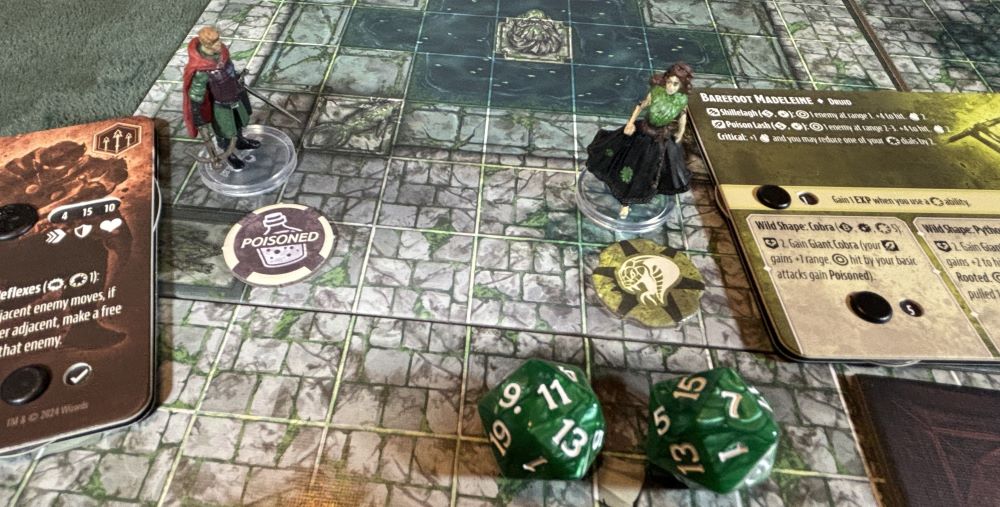
When it comes to gameplay, Tendrils of the Lichen Lich has a lot going for itself. The initiative system works great. While the initiative 1 card changes between players each round, the rest of the initiative cards are randomized. I like that players can then assign their initiative cards to their characters as they want. This provides some strategy to the game as players plan ahead what their characters will do. It is also nice to know where in the round the monsters will activate. You may want to try to defeat a monster before it activates, or run away from a monster before it attacks. I also really like the way actions are divided up so that each character gets one standard, one move, one bonus, and unlimited free actions. Plus the ability to downgrade a standard to either a move or bonus action, or downgrade a move to a bonus action provides even more flexibility for the player. For example, if a player wants to get a treasure chest that is farther away than their speed value, they could change their standard action for a move action, then move twice their speed using both move actions, loot the chest with their bonus action, and equip the item they found with a free action. Finally, the unique abilities of each character can provide some interesting tactics.
There is a lot of play in the starter box for this game. Yet WizKids has already added even more with several expansion packs that are currently available as well as more on the way. These include two faction packs: the Red Wizards and the Many Arrows. Each has a complete party of six characters complete with miniatures, dial cards, level up cards, and more. Plus there are expansion packs for both the Harpers and the Zhentarim from the core set, as well as the Red Wizards and Many Arrows, each with four new characters. If that were not enough, there is also a Sellswords expansion with four new characters who act as mercenaries and can join any faction. Expansions for both The Lord’s Alliance and Emerald Enclave are also in the works.
Dungeons & Dragons: Onslaught–Tendrils of the Lichen Lich is a fun game which is made even better by adding the rich lore and theme of Dungeons & Dragons. Not only will fans of fantasy combat will enjoy this game, but players of skirmish games will also find a lot to like in it as well whether they are fans of Dungeons & Dragons or not. In fact, a player needs no background or experience with Dungeons & Dragons in order to have a great time playing Dungeons & Dragons: Onslaught–Tendrils of the Lichen Lich. I have played Onslaught since it was first released and have all of the expansions. However, I was glad that WizKids decided to release a starter set to help new players get into the system without being overwhelmed. It also has a lower price point than the original core set. With only three characters per faction, it is easier to learn the system and focus on those characters, their abilities, and how to play them. Even if you already are into the Onslaught system and have the core set and expansions, Dungeons & Dragons: Onslaught–Tendrils of the Lichen Lich is a great expansion in itself as it not only adds two new factions with six characters, it also features new monsters including two champion monsters as well as the four double-sided map tiles which can be used to create a variety of new maps for your skirmishes.
I thoroughly enjoy playing this game and highly recommend Dungeons & Dragons: Onslaught–Tendrils of the Lichen Lich as a great addition to the collections of players who like skirmish games with some depth and story, but don’t have the time or desire for lengthy setups or for painting miniatures. For more information, visit the Dungeons & Dragons: Onslaught page!
Click here to see all our tabletop game reviews. ![]() To subscribe to GeekDad’s tabletop gaming coverage, please copy this link and add it to your RSS reader. Disclosure: GeekDad received a copy of this game for review purposes.
To subscribe to GeekDad’s tabletop gaming coverage, please copy this link and add it to your RSS reader. Disclosure: GeekDad received a copy of this game for review purposes. 

